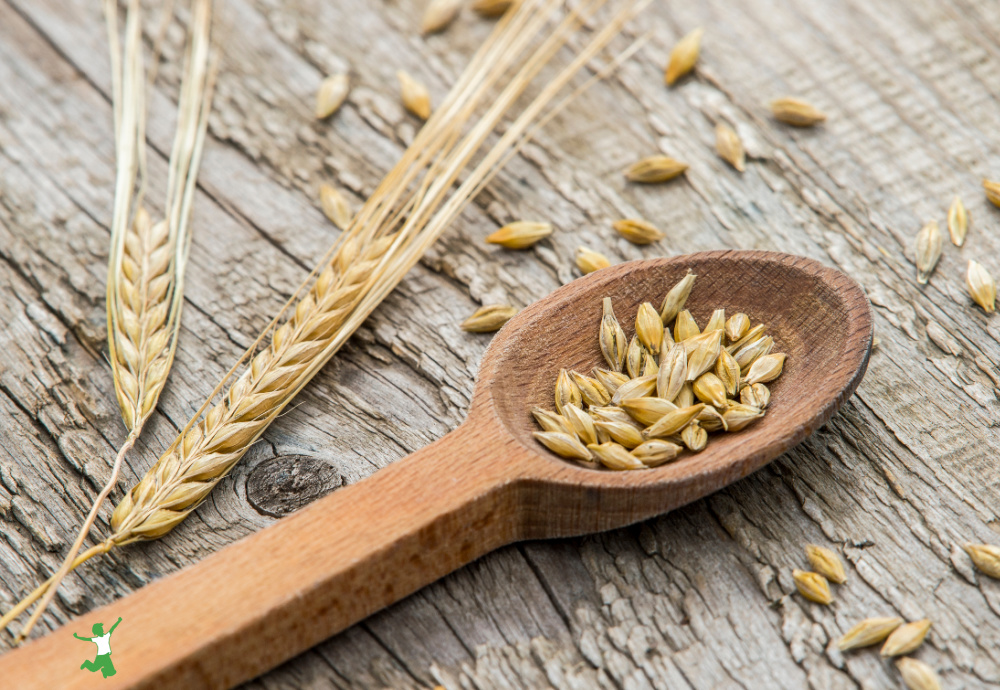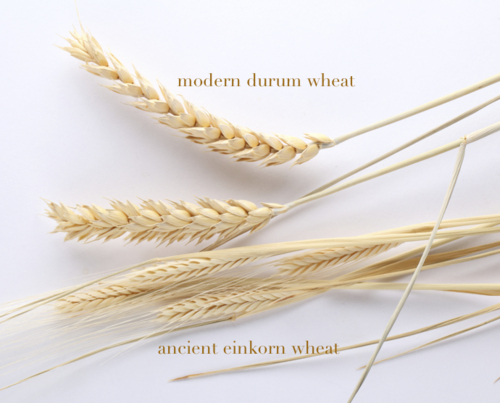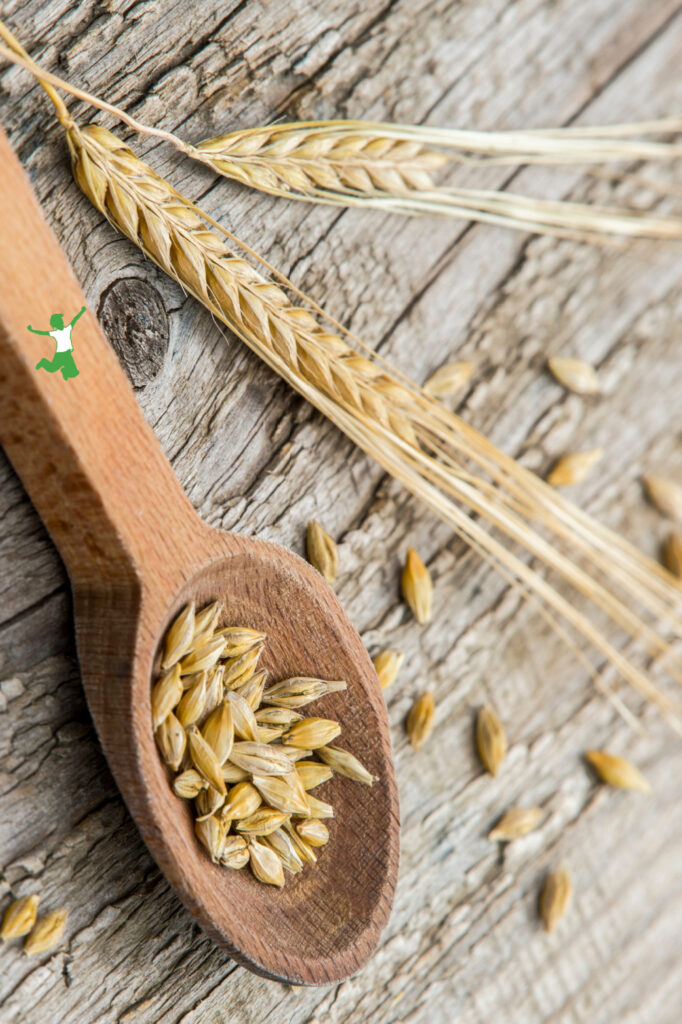There are four big reasons why einkorn is, by far, the best form of wheat to eat even when compared to other ancient grains like spelt, emmer, and kamut.

Most people who love to bake bread, pastries, and other goodies do not realize that einkorn is the best type of wheat to use.
Twenty-five or so years ago, I used to purchase organic white wheat (hard and soft) and spelt in bulk from a local grain co-op for my baking endeavors.
Grinding grain into fresh flour is certainly the most nutritious and tastiest way to bake! I also did this to avoid the conventional toxic wheat desiccated with gut-destroying glyphosate.
Caveat: Baking with freshly ground flour is only better if the bread is traditionally prepared.
Otherwise, the antinutrients like phytic acid are not broken down and harm to gut health is likely over time.
There certainly is a huge difference between modern processed wheat (hybridized by irradiation) and the organic, ancient grains you grind yourself at home.
I remember when I was breastfeeding my youngest child, if I ate so much as a mouthful or two of processed wheat at a restaurant, she would spit up for one or sometimes even two days!
If I ate organic wheat that I ground myself and either sprouted, soaked, or sour-leavened (sourdough), however, she never had any spit-up issues.
To me, this was a huge testament to the radically improved digestibility of wheat that is prepared using the wise methods of ancestral cultures.
Beware of persuasive influencers who claim that all you need to do is grind freshly ground flour and bake bread with baker’s yeast with no proper preparation such as soaking, sprouting or sour-leaving the dough necessary.
This approach is not how traditional societies ever baked their bread, and it is a recipe for serious gut issues!
Most people do not know that baker’s yeast is actually a modern invention only used in the past few centuries!
It quickly gained traction because it made baking faster and easier (NOT healthier). This is the case even when using freshly ground flour!
These quick rise breads using baker’s yeast gradually displaced traditional sourdough to the detriment of those who embraced this early “modern” cooking convenience.
Einkorn Benefits over Modern Wheat
With traditional baking the way to go (using a sourdough starter and NOT baker’s yeast), let’s talk about einkorn as the best type of wheat to bake with.
There are four reasons why I prefer to bake with einkorn wheat and no other type of ancient grains.
This isn’t to say I never use anything else, but if given the choice, I prefer to use einkorn.
Note that einkorn is not to be confused with farro or heirloom wheat.
Better Taste
My first experience baking with einkorn occurred after I received a thoughtful gift of, among other things, einkorn flour and wheat berries. I was delighted when I ground the einkorn into flour and saw how light and white it was.
I am not a fan of bran and am not of the food philosophy that all that fiber is actually good for your gut.
Fiber is a band-aid that covers up the root causes of constipation, a very common symptom of gut imbalance.
I recommend the book Fiber Menance as a good read on the subject.
The truth is that the unhybridized form of wheat…einkorn is the only one…does not have that much bran!
I was thrilled to see that my family thoroughly enjoyed the soaked waffles made with freshly ground einkorn flour.
Later on, I learned to make sprouted einkorn waffles that were more convenient but still highly digestible.
From that point, I gradually incorporated using einkorn for all my baking needs including this very popular no knead sourdough bread recipe.
Most Digestible
Because einkorn is unhybridized and low in bran, it is the most digestible form of wheat you can eat.
While my properly prepared grain dishes made with white wheat or spelt digest fine for our family, you can tell that the same dishes make with einkorn feel even better in the stomach.
This is possibly because einkorn contains good gluten, different on a molecular level from modern gluten in all other forms of wheat including ancient grains like spelt.
Better digestion means better absorption of nutrients, so einkorn surpasses the competition in that category as well.
Visually Distinctive

The first thing I noticed when I ground einkorn into flour for the first time was how much smaller a grain of einkorn is compared with a grain of modern wheat. They are about half the size!
In addition, I noticed that my grain grinder makes less noise when grinding einkorn berries into fresh flour because of softer, low bran kernels.
The distinctive crease on one side of a grain of modern wheat is also absent from kernels of einkorn.
The reason for the differences is that over the centuries, the genetics of wheat gradually changed due to human cultivation practices.
Year after year, farmers selected the seeds at harvest time that suited the goal of higher yields and MORE gluten.
This worked best for big farms and larger-scale agriculture, production, and distribution of wheat products.
The ONLY Unhybridized Wheat

Einkorn is like most plants in that it is diploid.
This means that einkorn contains only 2 sets of chromosomes.
About 2,000 years after einkorn wheat, nature created emmer via the natural hybridization of 2 wild grasses.
Consequently, emmer has 4 sets of chromosomes. Kamut and durum (bulgur) wheat are both descendants of emmer.
Spelt, an heirloom wheat, is the result of hybridization between cultivated emmer and another wild grass. Thus, spelt contains six sets of chromosomes.
Modern wheat is a descendant of spelt.
As you can see, einkorn is the purest and most ancient form of wheat available. With only 2 sets of chromosomes, a very different composition of gluten, and low bran, it is the most digestible form of wheat for baking at home.
Where to Source Quality Einkorn
The only downside of einkorn is that it is not widely available and tends to be more expensive than other types of wheat. It is still quite new to the North American market.
If you are sourcing organic einkorn berries, I recommend this quality brand.
If you need organic sprouted einkorn berries for more convenient baking, this farm based in the United States is my preferred source.
Have you tried einkorn wheat yet? If so, what observations have you made about this ancient, unhybridized wheat?









I just made my first loaf of sourdough Einkorn bread following the instructions on the Jovial website. I followed the instructions day by day, not really knowing what I was doing. It was different than sourdough made with rye or spelt. The bread is beautiful and delicious! The website says the bread gets less dense after a few times, but I think my first loaf is heavenly. I gave up grains over a year ago, not for any digestive problems but because of a bit of weight gain. I’m going to try Einkorn (1 slice a day at the most) and see if it works better for me than the sourdough spelt and rye that I had eaten in the past. Again, it was yummy with butter on it!
Denise, I have read even this morning of people who are successful in sprouting their einkorn grains. I just want to be sure I have good grains from jovial. What do you make of this? Thanks!
Elsha, here is the source of my information. Growing/sprouting conditions vary and some may be more successful than others. Keep experimenting. Unlike what Eli Rogosa said, the absence of the hull makes the difference and it does not mean the berries are bad. This paragraph is from einkorn dot com:
Can I use these einkorn berries for seed?
Einkorn Wheat Kernels in the Hull
Einkorn grows natively in a hull that does not separate from the kernel during harvest. To prepare einkorn for food, we use a dehulling process to remove the hull from the kernel. The result is einkorn berries ready to be ground into flour and used for baking.
This makes einkorn very unique among varieties of wheat. Experts say the hull protects the kernel from disease and rot. As a result of this dehulling process, however, some of the berries do not sprout as well as they would if they had been left in the hull.
If you plan to use the einkorn you purchase from our website as seed, you should first test a small amount to verify that it does sprout according to your expectations.
At some point in the future, we hope to offer einkorn seeds for sale. For now, they are so rare that it’s impractical to offer them for sale.
Glad to read Denise’s comment that because einkorn comes to us de-hulled it probably won’t sprout (I was trying to sprout mine), but now I’m confused because Eli states that if einkorn doesn’t sprout we have dead grains and this doesn’t sound good to me. Is there someone who can provide some clarification on this?
I’ve been reading that spelt is NOT a hybrid grain.
Where did you find your facts about spelt, so that I can get in on the info.
Thanks.
Recipes for Einkorn Sprout Bread are posted on: growseed.org/einkorn.html
Contact me if you have questions.
My recipes for Einkorn Sourdough Sprout Bread is posted on: growseed.org/einkorn.html
It is made with organic einkorn grown on my little 12 acre farm in Colrain, MA,
Contact me if you have any questions.
Kindly,
Eli
Does anyone have a recipe for sprouted einkorn bread that they can share? I can’t seem to find one from Sarah.
Dr. Davis speaks positively of einkorn in Wheat Belly — at least that is what I read……you never want to overdo grains, but when you use them, einkorn is a great choice.
Why don’t you just give up wheat altogether? Your body doesn’t need it. If wheat is so good why is it enriched? Read “Wheat Belly” by Dr Davis and change your life for the better.
Dear Jack,
First of all … not all flours are “enriched”, not even all wheat flours. The questions being posed here are clearly outside of/beyond the current 101 hype re: basic gluten free living. This author has helped her husband recover from a wheat allergy(huuuuge!), keep her baby healthy while breastfeeding and is experienced and knowledgeable enough to have researched beyond the very basic/trendy gluten free world into ancient methodologies, hybridization/genetic truths and the difference between historical wheats and current ones. Kudos to her. For info and “rah rah rah”-ing re: the basic trendy gluten free rhetoric that’s out there…see the rest of the internet. P.s. I’ve been a cook for 40 years and baked with wheat, without wheat, whole grains, NO grains, gluten free, gluten friendly, vegan, macro, hunter based, etc.. I have felt ingredient quality change in my own hands and ingredient labels change for the worse within my lifespan several times(peppers getting harder, apples not turning brown anymore, wheat making me sick, etc etc) and seen books and food fads come and go. Right now it is extremely important to find the best sources of NUTRITION available. It’s not about “giving up” foods. It’s about refusing to buy the crap that’s being stocked on the shelves and finding the very few things that MAY be out there(or somewhere online or at a local venue/farm/forager). This thread is as far away from buying anything “enriched” as you can get so before you write a basic 101 type comment, pleeeeeeeeeease, oh pleeeeeeeeease READ what the others are writing and see what the actual articles and comments are troubleshooting.
AMEN!!!!!!!!
Einkorn are naturally in their hull. They are a hulled seed. When they are planted they must be planted with the hull intact in order to sprout. The berries we get from einkorn are not in their hull and therefore have a low chance of sprouting.